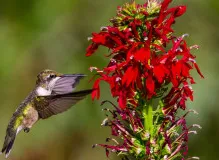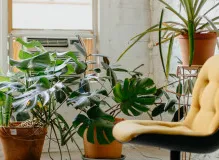For over long years, we have diligently conducted independent research and product testing. When you make a purchase through our links, we may earn a commission.
Discover the Ultimate Guide to Air Plants Care: A Step-by-Step Approach for Thriving Greenery!
Created: 3 weeks ago

41 min Read
Air plants have gained popularity in recent years due to their unique ability to thrive without soil. These fascinating plants, also known as Tillandsia, belong to the bromeliad family and can be found in various shapes, sizes, and colors. One of the most appealing aspects of air plants is their low maintenance requirements, making them a popular choice for both seasoned gardeners and beginners. In this guide, we'll explore the world of air plants and provide you with essential care tips to help your plants flourish. So, let's dive in! 🌿
Understanding Air Plants: What Makes Them Special
Air plants are native to the forests, mountains, and deserts of Central and South America, where they have evolved to absorb nutrients and moisture from the air around them. Unlike traditional plants that rely on soil for support and nourishment, air plants have specialized leaf structures called trichomes that allow them to absorb water and nutrients directly through their leaves.
The unique adaptations of air plants make them incredibly versatile and adaptable. They can survive in various environments, from rainforests to arid deserts, as long as they receive the necessary light, water, and air circulation.
Essential Care Tips for Air Plants
Light 💡
Proper lighting is crucial for the health and growth of your air plants. Place them in a location where they can receive bright, indirect light. Avoid exposing them to direct sunlight, as this can cause leaf burn. If natural light is limited in your space, you can supplement it with artificial lighting using fluorescent or LED lights.
Watering 💦
While air plants don't require soil, they still need regular watering to thrive. The best way to water your air plants is by misting them with water using a spray bottle. Alternatively, you can soak them in water for about 20-30 minutes every one to two weeks. After watering, make sure to shake off any excess water to prevent rotting.
Air Circulation 💨
Air plants need good air circulation to prevent rot and fungal diseases. It's essential to place them in an area with sufficient airflow. Avoid enclosing them in terrariums or containers without adequate ventilation. If you live in a humid environment, consider using a fan to improve air circulation around your air plants.
Temperature and Humidity 🌡️
Air plants thrive in moderate temperatures ranging from 50°F to 90°F (10°C to 32°C). They can tolerate higher temperatures for short periods but should be protected from extreme heat. As for humidity, most air plants prefer humidity levels between 50% and 60%. If the air in your home is dry, mist your air plants more frequently or provide them with a humidifier.
Fertilizing 🌿
Although air plants can absorb nutrients from the air, they will benefit from occasional fertilization. Use a balanced, water-soluble fertilizer formulated specifically for air plants. Dilute the fertilizer to half or one-quarter strength, and apply it to your plants during their regular watering routine. Be careful not to over-fertilize, as this can damage the plant's delicate roots.
Common Mistakes to Avoid
- Overwatering: Air plants are more susceptible to overwatering than underwatering. Ensure they have proper drainage and allow them to dry fully between watering.
- Insufficient light: Inadequate light can result in stunted growth and a decline in overall health. Find a bright spot for your air plants but avoid direct sunlight.
- Lack of air circulation: Poor air circulation can lead to rot and fungal diseases. Use fans or open windows to keep the air moving around your air plants.
- Forgetting about fertilization: While air plants can survive without regular fertilization, occasional feeding will promote healthier growth and vibrant foliage.
Conclusion
Air plants are captivating additions to any indoor or outdoor space. Their unique ability to survive without soil, coupled with their striking forms, has made them a favorite choice for plant enthusiasts. By following proper care techniques and providing them with the right conditions, you can enjoy the beauty and resilience of air plants in your own home. Remember to give them enough light, water them appropriately, ensure proper air circulation, and occasionally fertilize to keep them happy and thriving. 🌱✨
Benefits of Having Air Plants in Your Home
Air plants not only add a touch of natural beauty to your living space but also offer numerous benefits that make them an excellent choice for indoor plants. Here are some of the advantages of having air plants in your home:
1. Easy Maintenance 🌿
One of the main advantages of air plants is their low maintenance requirements. Unlike traditional potted plants, air plants don't require soil, which means you don't have to worry about watering them frequently or repotting them. Simply mist or soak them in water occasionally, provide them with adequate light and airflow, and they will thrive with minimal effort on your part.
2. Air Purification 🌬️
Air plants have the remarkable ability to improve indoor air quality by filtering and purifying the air around them. Through a process called sorption, air plants absorb harmful pollutants such as formaldehyde, benzene, and xylene, which can be found in household items like furniture, carpets, and cleaning products. Having air plants in your home can help create a healthier and cleaner environment.
3. Stress Reduction 😌
Bringing nature indoors has been proven to have a positive impact on mental health and well-being. Air plants, with their calming presence and soothing greenery, can help reduce stress, improve mood, and promote relaxation. Studies have shown that being around plants can lower blood pressure, reduce anxiety, and increase feelings of happiness and overall contentment.
4. Versatile Display Options 💡
Air plants are incredibly versatile when it comes to displaying them in your home. Since they don't require soil, you can get creative with how you showcase them. Place them in glass terrariums, hang them in decorative holders, attach them to driftwood or stones, or simply display them on a shelf or desk. The unique and often whimsical shapes of air plants make them visually appealing and add a touch of natural elegance to any space.
5. Educational and Interactive 🌱
Having air plants in your home provides an excellent learning opportunity for both children and adults. You can observe and study the unique growth patterns and reproductive processes of air plants up close. Additionally, caring for air plants gives you a chance to interact with nature and develop a deeper appreciation for the simplicity and beauty of these remarkable plants.
In conclusion, air plants are not only aesthetically pleasing but also offer a range of benefits that make them a fantastic addition to any home. Their easy maintenance, air purifying properties, stress-reducing qualities, versatility in display options, and educational value make them a popular choice among plant enthusiasts. So why not bring some air plants into your home and experience the joy and benefits they can bring to your living space?
When it comes to caring for air plants, it's essential to understand their unique needs and requirements. Although they are low-maintenance plants, they still require some attention to ensure their health and vitality. Let's delve into the key aspects of air plant care and discover how to keep these fascinating plants thriving.
Light 💡
Proper light exposure is crucial for the growth and development of air plants. These plants thrive in bright, indirect light. Place them near a window where they can receive partial sunlight throughout the day. However, be cautious not to expose them to direct sunlight for extended periods as it can scorch their leaves. If natural light is limited in your space, you can also use artificial lighting, such as fluorescent or LED lights, to supplement their light requirements.
Watering 💦
Watering air plants is a vital aspect of their care routine. Unlike traditional plants, air plants don't rely on soil for hydration. Instead, they absorb water and nutrients through their leaves. The ideal watering method for air plants is misting. Fill a spray bottle with room-temperature water and mist your plants thoroughly once or twice a week. Ensure that you cover both the leaves and the base of the plant. If your air plants seem particularly dry, you can also give them a soak. Submerge them in water for about 20-30 minutes, then gently shake off any excess water and allow them to dry before placing them back in their display.
Air Circulation 💨
Air circulation is paramount for the health of air plants. These plants thrive in environments with good airflow, which helps prevent rot and diseases caused by stagnant moisture. Ensure that your air plants have adequate ventilation by placing them in an area where there is sufficient airflow. Avoid enclosing them in terrariums or containers without proper ventilation. If you live in a humid area, using a fan or gently wafting air around the plants may be beneficial.
Temperature and Humidity 🌡️
Air plants prefer moderate temperatures ranging from 50°F to 90°F. They can tolerate higher temperatures for short periods, but it's crucial to protect them from extreme heat, which can cause damage. As for humidity, most air plants thrive in humidity levels between 50% and 60%. If you live in a dry climate or during the winter months when indoor heating can reduce humidity, it's essential to provide additional moisture to your air plants. Misting them more frequently or placing them near a humidifier can help maintain the required humidity levels.
Fertilizing 🌿
While air plants can derive nutrients from the surrounding air, they can benefit from occasional fertilization. Use a balanced, water-soluble fertilizer specifically formulated for air plants. It's best to dilute the fertilizer to half or one-quarter the recommended strength and apply it during the regular watering routine. Be cautious not to over-fertilize, as it can lead to burn or damage the plant.
By understanding and implementing these care tips, you can ensure that your air plants remain vibrant, healthy, and a beautiful addition to your indoor garden. Enjoy the unique beauty and low-maintenance nature of air plants as you embrace their care routine.
Creating the ideal environment is crucial for the health and well-being of your air plants. Here are some factors to consider when choosing the right setting for your plants' care.
Lighting: Adequate lighting is essential for air plants to thrive. Place your plants in a location that receives bright, indirect light. Bold sunlight can scorch the leaves, so be mindful of the intensity. Underlined The amount of light required can vary depending on the type of air plant, so it's important to research the specific needs of your plants. Some air plants can tolerate lower light conditions, but they may grow slower and produce fewer blooms. Italicized Experiment with different locations in your home to find the best lighting situation for your air plants.
Temperature: Most air plants prefer moderate temperatures between 50°F and 90°F. Extreme heat or cold can be detrimental to their well-being. Underlined Avoid placing them near drafts or in areas that experience temperature fluctuations. Italicized If you live in an area with temperatures outside of this range, consider providing additional protection or adjusting the environment accordingly.
Humidity: Air plants thrive in environments with moderate humidity levels (around 50-60%). Italicized To maintain the ideal humidity, mist your air plants regularly or place them in rooms with natural moisture, such as a bathroom or kitchen. Underlined If the air in your home is particularly dry, using a humidifier can be beneficial. Bold Creating a humid microclimate by grouping your air plants together can also help retain moisture.
Air circulation: Proper air circulation is essential for preventing the buildup of moisture and minimizing the risk of fungal diseases. Bold Italicized Ensure that your air plants are not placed in enclosed spaces with limited airflow, such as tight terrariums or containers without proper ventilation. Underlined Consider using a fan to improve air circulation, especially in areas with high humidity or stagnant air.
Watering: Watering air plants correctly is crucial for their care. Bold Overwatering can lead to rot, while underwatering can cause your plants to dry out. Italicized The best way to water air plants is by misting them with water or by submerging them in water for 20-30 minutes. Underlined It's important to shake off any excess water before returning them to their desired location. The frequency of watering will depend on factors such as temperature, humidity, and air circulation, so monitor your plants closely and adjust as needed. Bold Remember to observe the condition of the trichomes (small hairs on the leaves) – when they appear silver-gray, it's a sign that your air plants are hydrated.
By creating the right environment for your air plants, providing them with the necessary care, and staying attentive to their needs, you can enjoy the beauty and uniqueness of these fascinating plants for years to come. So, make sure to consider the lighting, temperature, humidity, air circulation, and watering requirements to create an optimal space for your air plants to thrive.
Taking care of air plants involves ensuring they receive adequate water to stay healthy and thrive. While air plants are known for their ability to absorb moisture from the air, they still require regular watering to keep them hydrated. In this section, we will explore different watering techniques that you can use to ensure your air plants receive the moisture they need.
Misting: One popular method of watering air plants is through misting. Using a spray bottle, you can mist your air plants to simulate the natural humidity they would experience in their native environments. When misting, make sure to thoroughly moisten the leaves, ensuring that water reaches the base of the plant as well. This technique is particularly beneficial during drier periods or in regions with low humidity.
Soaking: Another effective watering technique for air plants is soaking. To do this, you can submerge your air plants in room temperature water for about 20-30 minutes. This method allows the plants to fully absorb water through their leaves and replenish their moisture levels. After soaking, gently shake off any excess water and allow the plants to dry completely before placing them back in their display or container.
Drying: After watering your air plants, it is crucial to ensure they have adequate time to dry. Excess moisture can lead to leaf rot or other fungal diseases, so proper drying is essential for their overall health. Place your air plants in a well-ventilated area with good airflow to facilitate drying. Avoid placing them in areas with stagnant air or high humidity, as this can impede the drying process.
Frequency: The frequency of watering your air plants will depend on various factors, such as the humidity of your environment and the specific needs of your plants. In general, misting your air plants 2-3 times a week or soaking them once every 1-2 weeks is a good starting point. However, it's important to monitor your plants closely and adjust the watering frequency based on their individual requirements.
Water Quality: The quality of water you use is also an important consideration when watering your air plants. Tap water can contain chemicals like chlorine or fluoride, which can be harmful to air plants. The best option is to use filtered or purified water, or you can leave tap water out overnight to allow chlorine to evaporate before using it on your plants.
By following these watering techniques, you can ensure your air plants stay adequately hydrated and continue to thrive. Remember to observe your plants closely and make adjustments as needed. With proper care and attention, your air plants will reward you with their unique beauty and resilience.
Air plants care is a fascinating topic that has captured the attention of plant enthusiasts worldwide. These unique plants, also known as Tillandsia, have gained popularity for their ability to thrive without soil. In this introductory guide, we will delve into the wonders of air plants and provide valuable insights into caring for these remarkable botanical wonders. So, let's embark on a journey to discover the secrets of successful air plants care! 🌿
Understanding Air Plants: A Closer Look
Air plants belong to the bromeliad family and can be found in a variety of shapes, sizes, and colors. What sets them apart is their incredible adaptability and their ability to obtain nutrients and moisture directly from the air. In their natural habitats of Central and South America, air plants have evolved unique structures called trichomes on their leaves, which allow them to absorb water and nutrients without the need for soil.
The Basics of Air Plants Care
To ensure the health and longevity of your air plants, it is essential to provide them with the right conditions. Here are some key factors to consider when caring for your air plants:
1. Light Requirements
Light plays a crucial role in the growth and vitality of air plants. These plants thrive in bright, indirect light. Place them near a window where they can enjoy ample natural light, but be cautious of direct sunlight, which can scorch their leaves. If natural light is limited, you can supplement it with artificial lighting using fluorescent or LED lights.
2. Watering Techniques
Proper watering is vital to the well-being of air plants. While they don't rely on soil for nutrients, they still need regular moisture. There are different methods for watering air plants, depending on your preference and the size of your plants. One common technique is misting, which involves gently misting the leaves with water using a spray bottle. Another method is soaking, where you submerge the plants in water for around 20-30 minutes. Afterward, make sure to allow them to dry completely to prevent rot.
3. Air Circulation
Air plants require adequate air circulation to thrive. Ensure that they are placed in an area with good airflow. Avoid enclosing them in containers or terrariums without proper ventilation, as this can lead to the buildup of moisture and potential rot. If you live in a humid environment, consider using a fan or opening windows to enhance air circulation around your air plants.
4. Temperature and Humidity
Maintaining appropriate temperature and humidity levels is crucial for air plants care. These plants generally thrive in temperatures ranging from 50°F to 90°F (10°C to 32°C). While they can tolerate higher temperatures for short periods, it is best to protect them from extreme heat. As for humidity, most air plants prefer levels between 50% and 60%. If your environment is dry, misting your air plants more frequently or utilizing a humidifier can help provide the necessary moisture.
5. Fertilizing Techniques
While air plants can obtain nutrients from the air, they can benefit from occasional fertilization. Use a balanced, water-soluble fertilizer formulated for air plants. During their watering routine, dilute the fertilizer to half or quarter strength and apply it to your plants. Avoid over-fertilizing, as this can harm the plant's delicate structures.
In Conclusion
Air plants care is a captivating pursuit that promises unique botanical beauty and the enjoyment of a thriving plant. By understanding the basic needs of these remarkable plants - from light and water to air circulation and temperature - you can create a suitable environment for your air plants to flourish. Remember to provide them with the care they need and enjoy the wonder of these soilless marvels gracing your living space. Happy air plants care journey! 🌿💚
Air plants, also known as Tillandsia, have become increasingly popular in recent years. These unique plants are known for their ability to thrive without soil, making them a fascinating addition to any indoor or outdoor space. In this guide, we will dive into the world of air plants and explore their unique features and care requirements. Whether you're a seasoned gardener or a complete beginner, this article will provide you with the essential air plants care tips to ensure your plants flourish and thrive. So let's start by understanding what makes air plants so special.
Unique Features of Air Plants
Air plants are native to the forests, mountains, and deserts of Central and South America. What sets them apart from traditional plants is their remarkable ability to absorb nutrients and moisture from the air around them. This means they don't require soil to grow, making them incredibly adaptable and versatile.
One of the distinguishing features of air plants is their specialized leaf structures called trichomes. These tiny, hair-like structures cover the leaves of air plants and allow them to absorb water and nutrients from the atmosphere. With this unique adaptation, air plants can survive in a variety of environments, from humid rainforests to dry deserts.
Essential Care Tips for Air Plants
Now that we have a basic understanding of what makes air plants special, let's delve into the essential care tips to help these unique plants thrive.
1. Lighting Requirements
Proper lighting is crucial for the health and growth of air plants. Bright, indirect light is ideal for air plants. Place them near a window where they can receive sufficient light, but make sure to avoid direct sunlight. Direct sunlight can scorch the leaves and cause damage to the plant. If natural light is limited, you can supplement it with artificial lighting using fluorescent or LED lights.
2. Watering Techniques
While air plants don't need soil, they still require regular watering to stay healthy. The best way to water air plants is by misting them with water using a spray bottle. Aim to mist them once or twice a week, ensuring that the leaves are thoroughly wet. Another watering technique is soaking. Every two weeks, you can soak your air plants in a basin or sink filled with room temperature water. Allow them to soak for about 20-30 minutes, then remove them and gently shake off any excess water to prevent rotting.
3. Adequate Air Circulation
As the name suggests, air plants rely on air circulation to thrive. They need good air circulation to prevent rot and fungal diseases. It's crucial to place them in an area with sufficient airflow. Avoid enclosing air plants in terrariums or containers with insufficient ventilation. If you live in a humid area, consider using a fan to improve air circulation around your plants.
4. Temperature and Humidity
Air plants prefer temperatures between 50°F and 90°F (10°C to 32°C). While they can tolerate slight temperature fluctuations, extreme temperatures should be avoided. It's also important to consider humidity levels. Most air plants thrive in humidity levels ranging from 50% to 60%. If you live in a dry climate, misting your air plants more frequently or providing them with a humidifier can help maintain the ideal humidity levels.
5. Occasional Fertilization
While air plants can absorb nutrients from the air, they can still benefit from occasional fertilization. Use a balanced, water-soluble fertilizer specifically formulated for air plants. Dilute the fertilizer to half or one-quarter strength and apply it during the regular watering routine. Avoid over-fertilizing, as it can damage the plant's delicate trichomes.
By following these essential care tips, you'll be well on your way to cultivating thriving and beautiful air plants in your home or garden. Remember to observe your plants closely and adjust the care routine accordingly. With a little attention and care, your air plants will reward you with their unique beauty and fascinating growth habits.
When it comes to choosing the right air plants for your collection, there are several factors to consider. Air plants care can vary depending on the species, so it's essential to select plants that align with your preferences and capabilities. Let's explore some key factors to help you make an informed decision.
1. Size and Growth Pattern 📏
Air plants come in various sizes, ranging from tiny specimens that fit on your fingertip to larger plants that can take up a significant space in your display. Consider the available space you have and the desired aesthetic when selecting the size of your air plants. Additionally, different species have different growth patterns, with some forming clumps, while others grow tall or spread out.
2. Light Requirements 💡
Understanding the light requirements of air plants is crucial for their overall well-being. While most air plants thrive in bright, indirect light, some species can tolerate lower light conditions. Consider the lighting in your intended location and choose air plants that will thrive in that environment. If you're unsure about the lighting levels in your space, opt for more adaptable species that can tolerate a range of light conditions.
3. Watering Needs 💦
Watering is an essential aspect of air plant care. Some air plants require more frequent watering, while others can tolerate periods of drought. Consider your watering routine and capabilities when selecting air plants. If you prefer low-maintenance plants, choose species that are more forgiving of occasional neglect. On the other hand, if you enjoy the ritual of caring for your plants, you can opt for species that require more frequent misting or soaking.
4. Temperature and Humidity Tolerance 🌡️
Air plants have varying temperature and humidity requirements. Some species thrive in cooler temperatures, while others prefer warmer climates. Consider the average temperature and humidity levels in your home or the intended location for your air plants. Keep in mind that extreme fluctuations or prolonged exposure to unfavorable conditions can affect the health of your plants.
5. Aesthetic Appeal 💚
Lastly, consider the overall aesthetic appeal of the air plants you choose. Air plants come in various shapes, colors, and textures, offering endless possibilities for creating unique displays. Consider how the air plants will complement your existing decor or how you can arrange them in a way that showcases their beauty. Don't be afraid to mix and match different species to create visually stunning arrangements.
By taking these factors into account, you can select air plants that not only align with your care capabilities but also bring joy and beauty to your space. Remember, air plant care is an ongoing journey, and with proper attention, your plants will thrive and continue to captivate with their unique charm.
Light Requirements for Air Plants
Proper lighting is essential for the health and growth of your air plants. These unique plants thrive in bright, indirect light conditions. Place them near a window where they can receive ample light, but make sure to avoid direct sunlight. Direct sunlight can scorch the leaves of air plants, causing damage and discoloration. If natural light is limited in your space, you can supplement it with artificial lighting using fluorescent or LED lights. Position the lights about 6-12 inches above the plants and provide them with 12-14 hours of light per day.
Watering Air Plants: Finding the Right Balance
Watering air plants can be a bit tricky, as they don't require soil and have unique water absorption abilities. Proper watering is crucial for the health of your air plants. The most common methods of watering air plants are misting and soaking.
Misting involves spraying water onto the leaves of the air plants using a spray bottle. This method mimics the natural conditions air plants experience in their native environment, where moisture is obtained from mist and rain. Mist your air plants 2-3 times a week, making sure to thoroughly wet all the leaves.
Soaking is another method of watering air plants, particularly useful for larger or denser plants. To soak your air plants, simply submerge them in room temperature water for 20-30 minutes. After soaking, shake off any excess water and allow the plants to dry completely before returning them to their display. Soak air plants once every 1-2 weeks to ensure they receive enough moisture.
Remember, finding the right balance is key when it comes to watering air plants. They prefer to be slightly damp but should never be left sitting in water or become completely dry.
Temperature and Humidity: Creating the Ideal Environment
Air plants thrive in moderate temperatures ranging from 50°F to 90°F (10°C to 32°C). They can tolerate higher temperatures for short periods but should be protected from extreme heat or cold. When positioning your air plants, ensure they are not exposed to direct drafts or temperature fluctuations.
As for humidity, air plants appreciate moderate humidity levels between 50% and 60%. If you live in a dry climate or during the winter months when indoor humidity tends to drop, increase humidity around your air plants by using a humidifier, placing them on a tray of water-filled pebbles, or misting them more frequently.
Careful Fertilization for Optimal Growth
While air plants can absorb nutrients from the air, they can benefit from occasional fertilization. Using a balanced, water-soluble fertilizer formulated specifically for air plants, dilute the fertilizer to half or one-quarter strength. Apply the diluted fertilizer to your air plants during regular watering routines, ensuring the leaves are fully wetted. Be careful not to over-fertilize, as this can harm the plants. Fertilize air plants once every 1-2 months during the growing season (spring and summer).
Creating the Perfect Air Circulation
To thrive, air plants require good air circulation. This helps prevent rot and fungal diseases that can occur when moisture lingers too long on the leaves. When choosing a spot for your air plants, ensure there is adequate airflow around them. Avoid enclosing them in closed containers or terrariums without proper ventilation. If you notice the plants are not drying out between waterings or the environment is particularly humid, consider using a small fan to improve air circulation.
By providing the right amount of light, water, temperature, humidity, and air circulation, you can ensure your air plants receive the essential care they need to thrive and beautify your space. Remember to observe your plants closely for any changes and make adjustments to their care routine accordingly. With proper care, your air plants will continue to delight you with their unique beauty and resilience.
When it comes to air plants care, one crucial factor that must not be overlooked is proper air circulation. Adequate airflow around the plants is essential for their overall health and well-being. Let's explore why proper air circulation is important and how you can ensure that your air plants receive the fresh air they need.
🌬️ Why Air Circulation Matters
Air plants rely on good airflow to prevent the build-up of excess moisture, which can lead to rot and fungal diseases. Without proper ventilation, stagnant air can create the perfect environment for harmful pathogens to thrive. By ensuring sufficient air circulation, you can help maintain a healthy and thriving environment for your air plants.
🌿 How to Promote Air Circulation
There are several ways you can promote air circulation around your air plants to maintain their optimal health:
-
Placement: Position your air plants in an area where there is natural air movement, such as near a window or fan. This will help facilitate the flow of fresh air and discourage the accumulation of stagnant air.
-
Avoid Enclosed Containers: While it may be tempting to display your air plants in glass terrariums or containers, it's important to ensure that there is adequate ventilation. Enclosed spaces can restrict airflow, trapping moisture and increasing the risk of plant diseases. If you choose to use containers, opt for ones with openings or mesh lids to promote air circulation.
-
Regular Air Movement: You can further enhance air circulation by gently moving the air plants from time to time. Lightly shaking or rotating the plants will help disperse any stagnant air pockets and provide a continuous flow of fresh air.
-
Use Fans: If you notice that the air in your home or growing space tends to be still, consider using a fan to improve air movement. A gentle breeze will not only promote air circulation but also help to reduce the risk of moisture buildup.
-
Avoid Overcrowding: Give your air plants ample space to "breathe" by avoiding overcrowding. When plants are placed too close together, it restricts the airflow between them, making it challenging for air to circulate effectively. Allow enough space between plants to promote optimal ventilation.
By implementing these strategies, you can help create a favorable environment for your air plants. The improved air circulation will contribute to their overall health, reducing the risk of common issues caused by stagnant air.
Remember, proper air circulation is just one aspect of air plants care. Combined with other essential factors such as proper lighting, watering, and temperature control, your air plants will thrive and bring joy to your indoor or outdoor space.
When it comes to fertilizing air plants, there are a few dos and don'ts to keep in mind. While these fascinating plants can absorb nutrients from the air, providing them with occasional fertilization can help boost their growth and overall health. Let's explore some tips for fertilizing air plants effectively.
Dos for Fertilizing Air Plants:
-
Choose the right fertilizer: When selecting a fertilizer for your air plants, opt for a balanced formula specifically designed for epiphytic plants like air plants. Look for a water-soluble fertilizer with a nitrogen-phosphorus-potassium (NPK) ratio of around 10-10-10 or similar.
-
Dilute the fertilizer: Since air plants are sensitive to strong concentrations of nutrients, it's crucial to dilute the fertilizer before applying it. Mix the fertilizer at half or one-quarter strength, following the instructions on the packaging.
-
Apply fertilizer during watering: Air plants absorb nutrients through their leaves, so it's best to apply the diluted fertilizer during their regular watering routine. You can mist the plants with the diluted fertilizer or soak them in the solution for about 20-30 minutes.
-
Fertilize sparingly: While air plants can benefit from occasional supplementation, it's important not to overdo it. Fertilize your air plants once every three to four weeks during the growing season (spring and summer) and reduce or stop fertilization during the winter months when the plants are in a dormant phase.
-
Observe your plants: Keep a close eye on your air plants after fertilization. If you notice any signs of stress or burning on the leaves, it may be a sign that you're over-fertilizing. In such cases, rinse the plants thoroughly with water to remove excess fertilizer and adjust your fertilization schedule accordingly.
Don'ts for Fertilizing Air Plants:
-
Don't use regular houseplant fertilizer: Standard houseplant fertilizers may be too strong for air plants and can lead to nutrient burn. Avoid using fertilizer that is high in salts or contains urea. Stick to formulas specifically formulated for epiphytic plants.
-
Don't fertilize during dormancy: Air plants go through a period of dormancy during the winter months, where their growth slows down. Avoid fertilizing your air plants during this time, as they require fewer nutrients. Resume fertilization when the plants start showing signs of new growth in the spring.
-
Don't over-fertilize: It's better to under-fertilize than to over-fertilize air plants. Excessive amounts of nutrients can accumulate in the leaves, leading to leaf burn, root rot, and even plant death. Always err on the side of caution and use a diluted fertilizer solution.
By following these dos and don'ts for fertilizing your air plants, you can ensure they receive the right amount of nutrients without causing harm. Remember, air plants thrive on a delicate balance of light, water, air circulation, and occasional fertilization. With proper care, your air plants will continue to amaze you with their unique beauty and resilience.
Air plants are not only captivating with their unique growth habits and minimal care needs, but they also offer endless possibilities when it comes to displaying them in your home or office. Here are some creative mounting options that will showcase the beauty of your air plants while adding a touch of style to your space.
-
Wall-mounted terrariums: Create a stunning living wall by mounting a variety of air plants in small glass terrariums. Choose terrariums with openings that allow the plants to breathe and receive sufficient air circulation. Arrange them in an eye-catching pattern on a blank wall, and watch your air plants transform into living art pieces.
-
Driftwood and branches: Embrace the natural aesthetic by mounting air plants on driftwood or branches. These organic materials provide a rustic and earthy look while offering natural support for your air plants. Secure the plants to the wood using a thin wire or fishing line, and place your air plant creation on a shelf or mantle for a whimsical touch.
-
Hanging macrame planters: Elevate your air plants with trendy macrame plant hangers. These woven holders add a boho-chic vibe to any space while keeping your air plants suspended in mid-air. Choose intricately-designed macrame hangers that can accommodate the size of your air plants, and hang them near a window or in a corner for a stylish hanging garden effect.
-
Geometric holders: For a modern and geometric look, opt for metal or ceramic holders specifically designed for air plants. These sleek and minimalist holders come in various shapes and sizes, such as triangles, spheres, or cubes. Arrange them on a side table or bookshelf, and let the geometric shapes of the holders complement the unique form of your air plants.
-
Magnetic displays: Embrace the versatility of air plants with magnetic displays. Attach small magnets to the back of your air plants and place them on metal surfaces such as refrigerators or magnetic boards. This option not only showcases your air plants in a unique way but also allows you to easily rearrange them whenever you desire.
-
Glass globes and orbs: Create an ethereal and whimsical display by mounting air plants in glass globes or orbs. These transparent holders provide a striking view of the plants from all angles and create a mesmerizing floating effect. Hang them near a window or in an indoor garden space for a touch of enchantment.
Remember to consider the care needs of your air plants when choosing a mounting option. Ensure they have access to sufficient light, proper air circulation, and regular watering, even when mounted in creative displays. With these unique mounting ideas, you can transform your air plants into captivating decorative elements that breathe life into any space.
Air plants are not only fascinating to care for, but they also offer the opportunity to multiply your collection through various propagation techniques. This allows you to expand your air plant family and share the joy of these unique plants with others. Here are some tried and tested methods to propagate your air plants:
-
Pup division: Pups are small offshoots that grow from the base of the parent plant. To propagate through pup division, gently remove the pup from the parent plant once it reaches approximately one-third to one-half the size of the parent. Ensure the pup has some roots before separating it. You can then place the pup in a new location or container, following the same care guidelines as mature air plants.
-
Offsets or runners: Similar to pups, offsets or runners are smaller plants that emerge from the base of the parent plant. These can be detached and planted as individual air plants once they have developed roots. Simply use a clean, sharp tool to carefully separate the offset from the parent plant, taking care not to damage the roots.
-
Leaf cuttings: In some cases, you can propagate air plants from individual leaves. Select a healthy leaf, preferably one that has recently fallen off from the parent plant. Place the leaf on a suitable growing medium, such as a mix of sphagnum moss and perlite. Mist the leaf regularly to maintain moisture and provide it with bright, indirect light. With time, new roots and a new plantlet will emerge from the base of the leaf.
-
Seed germination: While it is less common, propagating air plants from seeds is another option. Keep in mind that air plants produce tiny seeds, so handling them requires precision. Gently scatter the seeds onto a suitable growing medium, such as a mix of fine orchid bark and peat moss. Mist the medium to keep it moist, and provide the seeds with bright, indirect light. With patience, the seeds will germinate, and you can continue nurturing them as they grow.
Remember, propagating air plants requires time and patience. Some methods may take longer than others to produce fully mature plants. Ensure you provide the appropriate care, including proper lighting, watering, and air circulation, to support the development of your propagated air plants.
Comparing different propagation techniques:
| Propagation Technique | Process | Time to Mature Plant |
|---|---|---|
| Pup Division | Separating pups from the parent plant | Fastest method; pups can mature quickly |
| Offsets or Runners | Detaching smaller plants from the base of the parent plant | Moderate speed; can take several months to mature |
| Leaf Cuttings | Placing individual leaves on growing medium | Slow process; can take several months to see new plantlets |
| Seed Germination | Sowing seeds on a suitable growing medium | Slowest method; can take several months to see germination |
Whether you choose to propagate your air plants through pup division, offsets, leaf cuttings, or seed germination, each method offers a unique and fulfilling experience. Experiment with different techniques to broaden your air plant collection and add variety to your indoor or outdoor space. Happy propagating! 🌱
Troubleshooting Common Issues: Common Problems and Solutions for Air Plants
While air plants are relatively easy to care for, they can still face a few common issues. Here are some of the most frequently encountered problems and their corresponding solutions to help you keep your air plants thriving.
1. Browning or drying leaves 🍂
If you notice that your air plant's leaves are turning brown or becoming dry, it may be an indication of dehydration. To remedy this, increase the frequency of watering. Mist your air plant more frequently or soak it in water for longer periods. Additionally, make sure your air plant is receiving adequate indirect light and proper air circulation.
2. Yellowing leaves 💛
Yellowing leaves can be a sign of overwatering or insufficient light. Ensure that you are not saturating your air plant with excessive water. Let it dry completely between waterings. If you suspect lack of light is the issue, move your air plant to a brighter location but avoid direct sunlight.
3. Root rot 🦠
Root rot can occur if your air plant is sitting in water for prolonged periods. To prevent this, make sure to shake off any excess water after watering and avoid using containers without drainage holes. If you notice signs of root rot, such as black and mushy roots, gently trim away the affected areas using clean scissors. Allow the plant to dry thoroughly before placing it back in its display.
4. Lack of growth or stunted growth 🚫🌱
If your air plant is not showing signs of growth or seems to be growing slowly, it may be due to insufficient nutrients. While air plants can absorb some nutrients from the air, they will benefit from occasional fertilization. Apply a diluted, water-soluble fertilizer specifically formulated for air plants during your regular watering routine. Be careful not to over-fertilize, as this can lead to burn or damage.
5. Pests 🐜🐛
Though relatively resistant to pests, air plants can occasionally attract unwanted visitors such as aphids or spider mites. If you notice pests on your air plant, remove them manually using a gentle touch or use a mild, organic insecticide to control the infestation. Be sure to thoroughly rinse the plant afterward and monitor it for any signs of reinfestation.
By being attentive to these common issues and following the appropriate solutions, you can ensure that your air plants stay healthy and vibrant. Remember to provide them with adequate light, water, air circulation, and periodic fertilization. With proper care, your air plants will continue to thrive and bring a touch of natural beauty to your home or office space.
As the seasons change, it's important to adjust your air plant care routine to ensure optimal growth and health. Each season brings its own set of environmental conditions that can impact your air plants, so let's explore some seasonal care tips to help you keep them thriving all year round.
Spring 🌸
During the spring, air plants naturally enter a period of active growth. It's important to provide them with ample light to fuel this growth. Place your air plants in a location where they can receive bright, indirect sunlight. If your climate allows, you can also move them outdoors to benefit from natural lighting. Increase the frequency of watering during this season, as the warmer temperatures and increased sunlight will cause your air plants to dry out more quickly. Remember to also provide sufficient air circulation to prevent any potential issues.
Summer ☀️
Summer brings warmer temperatures and increased humidity, which can create an ideal environment for air plants. However, it's crucial to protect your plants from prolonged exposure to direct sunlight, as this can cause leaf burn. Provide shade or move your air plants to a spot with indirect light. It's also important to adjust your watering schedule to account for the higher temperatures and potential evaporation. Monitor your plants closely and ensure they receive enough water, but be mindful not to overwater, as this can lead to root rot.
Fall 🍂
As the summer heat starts to fade, air plants begin to slow down their growth and enter a period of rest. During the fall, it's important to gradually reduce the frequency of watering. This will help prevent excessive moisture buildup, which can lead to rot. As the days get shorter and the temperatures drop, it's crucial to bring your air plants indoors or provide them with adequate protection if you live in a colder climate. Ensure they are kept in a well-lit location, as reduced daylight hours can affect their overall health.
Winter ❄️
Winter can pose some challenges for air plant care, as the colder temperatures, low humidity, and reduced light levels can impact their growth. It's important to provide extra protection during this season. If you live in a region with harsh winters, consider moving your air plants to a warmer location, such as near a humidifier or in a well-lit bathroom. Reduce your watering frequency even further, as air plants require less water during their dormancy period. Monitor your plants closely and adjust your care routine as needed to ensure they stay healthy.
By adapting your air plant care routine to the changing seasons, you can provide the optimal conditions for their growth and longevity. Remember to observe your plants closely, as each air plant may have its own unique needs and preferences. With attentive care and adjustments, your air plants will continue to thrive and bring a touch of natural beauty to your space all year round.
Are you looking to dive deeper into the world of air plants and expand your knowledge as an air plant enthusiast? Look no further! We've compiled a list of recommended resources that will provide you with valuable insights, tips, and inspiration for your air plant care journey. Whether you prefer books, online communities, or hands-on workshops, there's something for everyone to further their understanding of air plants and their care. Let's explore these resources together! 📚🌿
1. Books on Air Plant Care 📖
If you enjoy reading and want a comprehensive guide to air plant care, these books are a must-have:
-
"Air Plants: The Curious World of Tillandsias" by Zenaida Sengo.
This book provides an in-depth look at air plant varieties, their natural habitats, and practical care tips. With beautiful photographs and expert advice, it's a great resource for both beginners and experienced air plant enthusiasts. -
"Air Plants: The Essential Guide" by Paul T. Isley III.
Written by a renowned air plant expert, this book covers everything from selecting and caring for air plants to designing creative displays and terrariums. It's a treasure trove of information for those looking to take their air plant care to the next level.
2. Online Communities and Forums 💻🌿
Connecting with fellow air plant enthusiasts can be a great way to exchange knowledge and learn from experienced growers. Here are some popular online communities and forums to join:
-
The Air Plant Hub
This online community brings together air plant enthusiasts from around the world. You can find helpful discussions, share your own insights, and get advice from experienced growers. It's a fantastic platform for connecting with others who share your love for air plants. -
The Air Plant Forum
Another great resource for connecting with fellow air plant enthusiasts. The forum is filled with useful threads on various topics related to air plant care, including troubleshooting, display ideas, and trading or selling air plants. It's a vibrant community where you can ask questions and contribute to ongoing discussions.
3. Workshops and Events 🌿✨
For a hands-on learning experience, consider attending air plant workshops or events. These provide a unique opportunity to learn directly from experts and gain practical knowledge. Keep an eye out for local botanical gardens, nurseries, or horticultural societies that may offer workshops on air plant care and maintenance.
Additionally, check online event listings or social media platforms for upcoming air plant festivals or expos. These events often feature knowledgeable speakers, demonstrations, and vendors selling a wide variety of air plants and supplies.
Remember, expanding your knowledge and understanding of air plant care is an ongoing journey. These recommended resources are just the beginning. Stay curious, keep exploring, and don't hesitate to share your insights and experiences with others. Happy air plant care learning! 🌿📚











